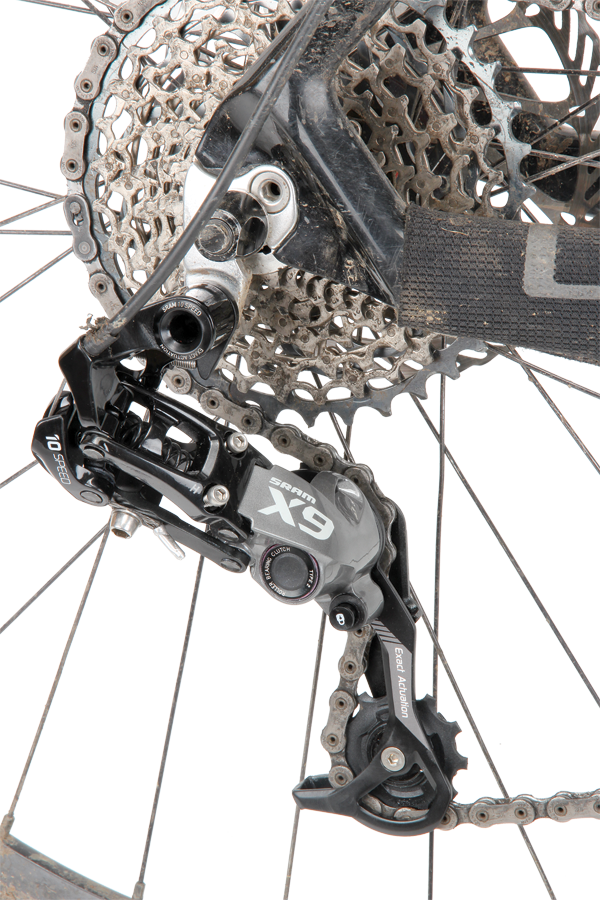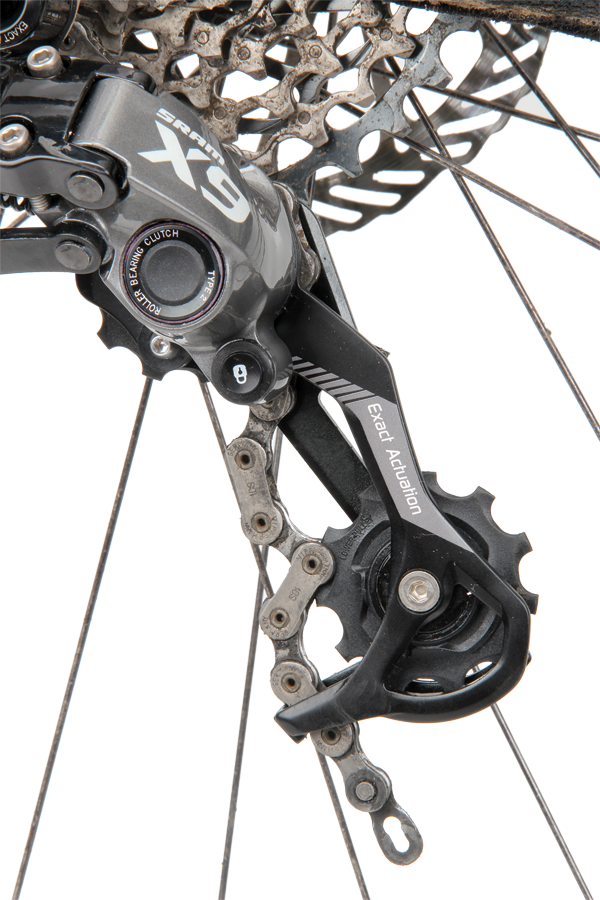SRAM X.9 Type 2 Derailleur
 Of late, the competition between SRAM and Shimano is doing great things for mountain bikers. Shimano has always been the manufacturing giant but six to eight years back SRAM really caught up. These days it seems each is forcing the other to make their gear better and better.
Of late, the competition between SRAM and Shimano is doing great things for mountain bikers. Shimano has always been the manufacturing giant but six to eight years back SRAM really caught up. These days it seems each is forcing the other to make their gear better and better.
In 2009 SRAM launched 2x10 and then Shimano followed. Next Shimano introduced its ‘Shadow Plus’ derailleur with a built in friction damper to control chain slap, now for 2013 SRAM has followed. Some may criticise for a lack of originality but I couldn’t care less if it leads to a better end product.
These derailleurs use a one-way clutch that allows the cage to spring back easily, but extra friction is applied when the cage moves the other way. This helps to reduce chain bounce and makes your bike quieter with less chance of dropping the chain. SRAM calls their system ‘Type 2’, and while the name may be somewhat unexciting, we were pretty keen to give it a try. Initially Type 2 will be offered as an option on X.9 and X.0 derailleurs, and rumour has it that Type 2 will become the only option for aftermarket sales—SRAM is that confident of its worth.
Compared to the traditional version, the Type 2 mechanism adds about 30g of weight and costs around $10 more (approximately $130 for the Type 2 X.9 model on test versus $120 for the standard version). Visually there’s not much between them, although the new system is a touch bulkier with the outer side of the cage pivot showing, rather than being concealed like the standard version. There’s also a little push-button with a padlock symbol on it, mounted to the derailleur cage—dubbed ‘Cage Lock’ it’s said to make wheel removal and mounting easier. Weight wise it came in at 246g—that’s 15g more than the Type 2 X.0 derailleur (which sells for twice as much) and around 50g lighter than the similarly priced Shimano SLX Shadow Plus unit.

When I first heard of the Cage Lock feature I thought it sounded like a solution to a problem that I didn’t have. As long as I place the chain in the smallest cog at the back, I never have any issues with wheel mounting or removal. Maybe it’s more aimed at new riders who haven’t got a handle on wheel removal I thought...
Once mounted to my bike, it only took a quick play to change my tune—Cage Lock is a terrific idea! These new age derailleurs make wheel removal harder as the cage doesn’t move as freely. That’s why Shimano has a switch that disables the friction damper on their Shadow Plus derailleurs. With Cage Lock, you pull the cage all the way forward (which takes more effort with the new system) and push the button. The cage then stays put with the chain hanging limp and there’s no longer a spring to fight against. It’s amazing how much easier this made wheel mounting, although it still helps to remember which gear you were in so you can put the chain on the right cog when putting the wheel back. Locking the cage forward also makes chain removal and joining much easier.
Similar yet Different
As mentioned before, Type 2 works by applying extra resistance to the cage when it moves forward but still allowing it to spring back as normal. It’s the same concept that Shimano introduced with Shadow Plus but the mechanicals are very different. Where Shimano uses a metal band to apply friction to the cage pivot, SRAM uses a needle roller bearing to apply the tension. While the amount of friction can be adjusted on the Shimano derailleurs, there is no such adjustment with the SRAM version.
Our experience has shown that the friction adjustment is necessary on the Shimano derailleurs, as the damping effect lessens over time. When this happens you can just crank it up again. The adjustment also allows you to vary the friction to suit differing needs—heavier damping for rougher trails or lighter for a softer feel at the shift lever.
With a roller bearing applying the cage tension as opposed to straight-out friction from a wrap around metal band, you’d have to think that the SRAM system would suffer less with wear. Only time will tell if this theory holds true and we haven’t had enough time on the new SRAM derailleur to make any judgment—all I can say is the resistance hasn’t changed after the dozen or so rides that we’ve had on the Type 2 derailleur.

SRAM’s factory set resistance level was lower than on a new Shadow Plus derailleur but firmer than a 12-month old Shimano derailleur. All of these new-style derailleurs produce a slightly firmer feel at the gear lever when shifting to a bigger cog; however I’d say that this effect was less apparent with the SRAM system and it produces a lighter feel overall.
With a slightly lower resistance level, the Type 2 derailleur still suffered a bit of chain slap, but only in the little chainring combined with the smaller rear cogs—not the sort of gear you’ll be using when descending or travelling at speed. Overall there was a noticeable reduction in chain bounce and the system was very quiet. As a non-adjustable system, it’s probably good that SRAM picked the middle ground; there’s enough friction to add control and reduce chain slap but not so much that it compromises the shifting quality. Whether this varies with age and wear is yet to be seen but Type 2 is clearly a positive step forward for SRAM. I see no reason why you’d choose a traditional X.9 or X.0 in lieu of a new Type 2!
Monza Imports (03) 8327 8080 / www.sram.com




